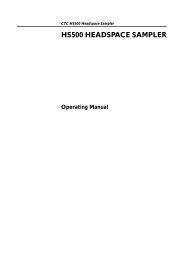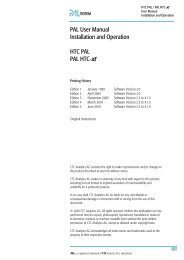Addendum to PAL User Manual Installation and ... - PAL System
Addendum to PAL User Manual Installation and ... - PAL System
Addendum to PAL User Manual Installation and ... - PAL System
Create successful ePaper yourself
Turn your PDF publications into a flip-book with our unique Google optimized e-Paper software.
<strong>Addendum</strong> <strong>to</strong> <strong>PAL</strong> <strong>System</strong> <strong>User</strong> <strong>Manual</strong><br />
<strong>PAL</strong> ITEX-2 Option<br />
If a split opening is observed, either reduce the injection speed from the<br />
ITEX-2 device, which should be done but without sacrificing the peak shape,<br />
especially as seen in early eluters, or reduce the column backpressure.<br />
Some GC manufacturers provide special EFC/EPC devices with different<br />
plumbing from the EFC/EPC <strong>to</strong> the injec<strong>to</strong>r, which adapts <strong>to</strong> such special<br />
cases <strong>and</strong> stabilizes the baseline as well. For further information contact<br />
your GC manufacturer representative.<br />
2.5. GC Column Oven<br />
No recommendation can be given for column oven temperature.<br />
This parameter is highly dependent on the application.<br />
For very highly volatile compounds, select a starting temperature of<br />
30- <strong>to</strong> 35 °C. This low temperature permits focusing the sample at the<br />
column inlet. Cryo-cooling the oven <strong>to</strong> this low starting temperature is<br />
advised.<br />
2.6. GC Column<br />
The type of GC column also depends greatly on the application <strong>and</strong> detection<br />
device for the GC system. If a low starting temperature is used, check also the<br />
lower temperature limit of the GC column. Some column phases cannot be<br />
used at such low temperatures.<br />
For highly volatile compounds, focusing at the column entrance is important.<br />
Use a greater film thickness <strong>to</strong> permit better trapping. A greater film thickness<br />
normally causes greater bleeding, which will affect the baseline <strong>and</strong> detec<strong>to</strong>r<br />
stability. Compromise on film thickness with the temperature range used for<br />
the column <strong>and</strong> the detection type (MSD is critical <strong>to</strong> bleeding).<br />
2.7. Injection Speed<br />
The injection speed depends <strong>to</strong> the volatility of the analyte. Very highly<br />
volatile compounds can be injected (thermally desorbed) at a speed of<br />
approximately 100 µL/s. Less volatile compounds can be injected at a speed<br />
of 20 <strong>to</strong> 100 µL/s. Finding the right injection speed for a specific application<br />
is based mainly on judging the peak shape. Is any dis<strong>to</strong>rtion or even peak<br />
splitting visible?<br />
3. Contamination of the Analytical Device<br />
It is important <strong>to</strong> realize that the ITEX Technique is a very efficient sample<br />
enrichment technique. As described, detection levels in the ppt range can<br />
be achieved. However, each step in the h<strong>and</strong>ling <strong>and</strong> device setup must be<br />
considered with care with respect <strong>to</strong> any possible contamination.<br />
Contamination of the analytical device originates from several sources, as<br />
described below.<br />
40




